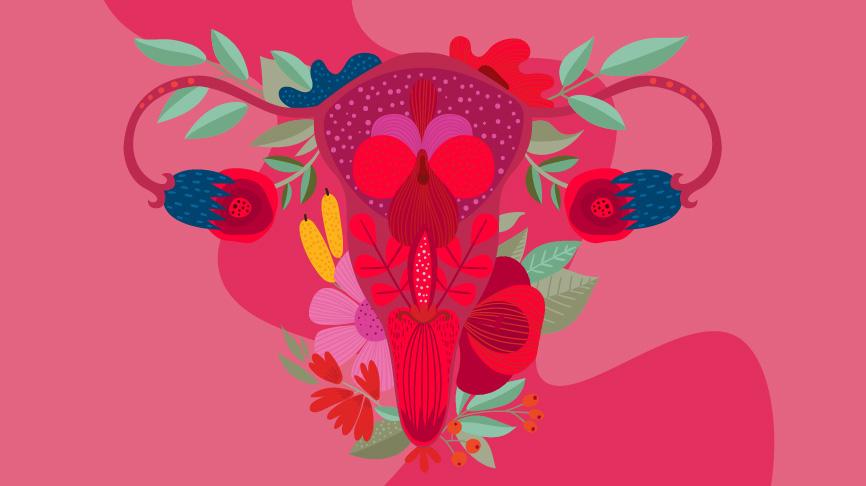More than just the vagina – the female reproductive organs

You’re probably familiar with the basics of your lady parts. (Who can forget those early sexual health classes?) There are breasts, a vagina and the all-important clitoris… and a bunch of other stuff. It’s not uncommon for women (and men) to gloss over the details of what’s going on “down there”, but really getting to know your body, inside and out, helps ensure lifelong health, not to mention just helping you be comfortable with yourself. And really, you should be proud of your body, because it’s pretty darn cool! It can make babies and sustain them after birth. Plus, it can have multiple orgasms, and it doesn’t get much better than that. So check out our crash course on your inner self. (Want to learn more about your outer private parts? Check out Know Thyself: The Vagina and the Vulva)
South of the Belly Button
Let’s take it from the top:
Uterus – The womb, the baby-maker, the uterus. It has many names, and one big job: it’s all about babies. The uterus is actually made of two parts: the cervix, which is the base of the uterus, and the corpus, the main part of the uterus. (More on the cervix below.) Every month, the lining of the corpus thickens in preparation for pregnancy and, if no pregnancy occurs, is shed as – you guessed it – menstrual fluid.
Cervix – We’re giving this its own section, because it’s a lot more important than many people give it credit for. The cervix is the lower part of the uterus that connects to the vagina. It’s about 4 cm long, is what stops bacteria (and other things) from entering your uterus, and allows menstrual fluid to leave your body. You can actually feel your cervix if you insert a finger into your vagina – it feels a little like the tip of your nose. Find out how to locate your cervix and why it’s important (especially for menstrual cup users) in our full article here.
Ovaries – If you want to get technical, these are the real baby-makers. Ovaries are the female gonads, and are responsible for producing hormones and the all-important egg. They’re about the size of an almond. A woman is born with all the eggs she will ever have: at birth, there are approximately 2 million, but by puberty about 300,000 remain. Roughly every month (around every 28 days), one egg matures in your ovaries and is released, where it waits to be fertilized. If it’s not fertilized, it is shed out of the uterus during your period.
Fallopian Tubes – Fallopian tubes are two – yep – tubes that are each about four-inches long, and are generally where an egg is fertilized by the sperm. They also carry a fertilized egg from the ovary to the uterus.
Vagina – Many people (both male and female) think that “vagina” refers to everything in your nether-regions. Sorry, it’s not that simple! The vagina is the muscular, elastic tube that connects the uterus to the outside of your body (aka the vulva), carrying menstrual fluid or a baby to the outside world. It’s roughly 3 inches long and 1 inch wide, and because of its elasticity, it can expand by up to 200% to accommodate a penis, tampon, menstrual cup or a baby. It’s also slightly acidic to provide a good place for healthy bacteria to thrive. (Get the facts on vaginal pH and how to keep it balanced here).
Hymen – We can’t talk about the vagina without talking about the hymen, aka the vaginal corona. The hymen is a small membrane that partially covers or surrounds the opening of your vagina. Most hymens are shaped like a half-moon, but there are actually several different shapes and sizes. And no, your hymen doesn’t “break” the first time you have sex. It already had a hole (or two) in it to allow menstrual fluid and discharge to leave your body.
Bladder (urethra) – You probably already know that the bladder is where urine goes before it is removed from your body. When it’s empty, just like the uterus, it’s about the size and shape of a pear. And let’s get one thing straight, ladies (and gentlemen!): women do not pee through their vagina. Urine leaves the body via the urethra, which runs from your bladder to an opening just below your clitoris.
And a bonus: Your Pelvic Floor
Pelvic floor – You probably don’t think about the pelvic floor as one of your “down there” things. But it plays a big role in ensuring that your ladybits work properly. Your pelvic floor muscles sit like a hammock between your pelvic bone and the base of your spine, supporting your internal organs. These muscles wrap around the urethra and vagina, and can actually be consciously controlled. Have you ever stopped urine mid-flow? That’s the pelvic floor at work. The pelvic floor plays a crucial role in helping us control our urination and bowel movements, and can even improve the intensity of your orgasms. It also helps us push a baby out when we have a vaginal delivery.
Important muscles like these need to be exercised, and the best way to do that is by doing Kegel exercises. You can learn more about how Kegels work and why they’re important for every woman, no matter what stage of life you’re in, here.
There you have it, your crash course on female anatomy. There’s a lot to learn, but taking the time to get to know your body will help you become more comfortable with it, and more aware of when something feels “not right”. There’s no reason to be embarrassed by your body, so embrace it – learn the “real words” and use them!

A collective group of “lady experts” at Intimina who love sharing our personal experiences, even when they are a little too personal. We believe it’s time to start breaking down the taboos around menstruation, motherhood, and menopause, and start owning our female health.


